- Yachting World
- Digital Edition


World’s coolest yachts: Tornado catamaran
- April 20, 2021
We ask top sailors and marine industry gurus to choose the coolest and most innovative yachts of our times. This month, Carolijn Brouwer nominates the Tornado catamaran

“The Tornado catamaran is a really cool boat. It was my introduction to high performance sailing and it had a big influence on me in many ways.
“Once you get a taste for it, there is no way back. Sailing the Tornado opened up different doors for me in my sailing career,” says Carolijn Brouwer .
The Tornado catamaran was for many years the fastest Olympic sailing class and was the first catamaran to be introduced to the Olympic Games. It was first sailed in the 1976 Olympic Games and saw its last Olympic appearance in 2008.

There was not multihull option for sailing at the Olympic Games in 2012, but the Tornado undoubtedly led the way for the current catamaran class, the Nacra 17, which must be sailed with a female and a male member of the crew.
“Sailing the Tornado is where I got the feel for apparent wind sailing. It’s a pretty big cat in the small boat sailing world with its 20ft length and 10ft width creating decent loads and righting moment.
“Also, the Tornado was the only Open discipline at the Olympic Games but it was extremely male dominated.”
Brouwer helmed for Belgium at the 2008 Games, sailing a Tornado catamaran with crew Sébastien Godefroid. “I hope this showed that being a woman you can compete at a high level and be very competitive against men in a mixed gender configuration – just like the great Paul Elvstrøm did sailing with his daughter.”
Tornado catamaran stats rating:
Top speed: 20 knots LOA: 20ft/6.1m Launched: 1967 Berths: 0 Price: £23,000 Adrenalin factor: 70%
Carolijn Brouwer
A three-time Whitbread/Volvo Ocean Race crew, Carolijn Brouwer is also a three-time Olympian. She was born in the Netherlands and represented the country at the 2000 and 2004 Olympics in first the 470, and then the Europe. She then switched to the Tornado, representing Belgium in 2008, when she finished 12th.
If you enjoyed this….
Yachting World is the world’s leading magazine for bluewater cruisers and offshore sailors. Every month we have inspirational adventures and practical features to help you realise your sailing dreams. Build your knowledge with a subscription delivered to your door. See our latest offers and save at least 30% off the cover price.
Browse by Category
- Coach of the Year
- High School Sailing Team of the Year
- Optimist Sailor of the Year
- Sailing Fitness
- Regatta News/Results
- Boat Speed/Tuning/Sailtrim Articles
- General Sailing News
- Coaches Locker Room
- From the Experts
- Profiles in Pro Sailing
- Featured Jobs
- Marketplace Ads
- Skip to primary navigation
- Skip to main content
- Skip to primary sidebar
- Skip to footer
Sail1Design
First Name*
Email Address*
November 30, 1999 by Sail1Design Editor Leave a Comment
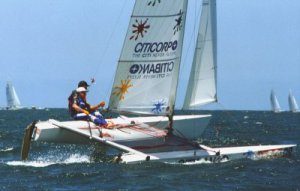
The Tornado was designed in the autumn of 1967 by Rodney March from England, with help from Terry Pierce, and Reg White, specifically for the purpose of being the new Olympic Catamaran, which was to be selected by the IYRU in an Olympic Catamaran Trials. The boat was developed mainly in Brightlingsea, England.
International Status was granted to the Tornado as a result of its outright winning of the IYRU Trials held in England. The next step, adding the Catamaran event to the Olympic program, occurred two years later, with the result that the first Catamaran event, sailed in 1976 in Canada, was sailed in the Tornado. The Tornado is an outstanding example of a class that was designed specifically for Olympic competition that has become a successful International class on its own merits.
2000 Olympic Silver Medalists: Darren Bundock and John Forbes (AUS)The Tornado has since remained unchallenged as the ultimate one-design catamaran. With its modern, stylish rigging and sleek lines the Tornado is quick to catch the eye of any water-drawn on-looker as it speeds across harbors, lakes, and oceans in over 30 countries around the world. With its ability to reach speeds of 15-18 knots upwind and downwind, and 33+ knots reaching, the Tornado is truly the purists’ speed machine.
Over 4,800 Tornados have been built, with 1,200 class association members worldwide. In 2004, on the Saronikos Gulf in Greece, the Tornado will be sailing in its seventh Olympic Games.
Except for refinements in technical details – improvements in hull, sail, and spar technology, better blocks and lines – the Tornado was unchanged from its beginnings in to the early 90’s. Then, as a result of the increasing popularity of other, smaller catamarans, the Tornado class undertook a major development program in 1993. It was specifically to respond to a request from the IYRU to search for ways to improve the public and media awareness of the sport of yachting, and secondarily to answer the possible challengers to its ‘top cat’ role.
Two weeks of intensive on-the-water testing and development took place in Miami, following considerable discussion and planning. Among the participants were the three medalists from Barcelona as well as designer Reg White. The International Tornado Association spent nearly US$22,000 on the testing, evaluation, reporting, and finally balloting process to the class membership, to find the fairest and best ways to improve the class and the sport in ways acceptable to the sailors.
The testing involved 10 standard and fully competitive Tornados, one boat with a larger main and jib, and two boats with a variety of sailplans that included spinnakers of up to 32 sq. M. Fourteen races were run over the testing period in addition to in-line speed and handling evaluations.
As part of the testing process, new courses were also used, most involving a leeward gate.
Following the testing and regatta, the following points were clear; the larger main/jib combination was only marginally faster than the standard rig, and the spinnaker boats were a surprise, only beating the standard rigs in 2 of the 14 races. The ITA then balloted the class membership, with not only the conclusions but also all of the data and the testing procedure, helping to provide insights to the rig selection process.
A two-thirds majority is required by the class constitution to implement any change; this majority was not reached, the class voting against the expense of a change with no real benefit to sailing. Thus the class retained the same sailplan for the next two Olympics. The course changes, giving the possiblity of better spectator access and greater media coverage, received the votes necessary to be adopted by the class.
The Class felt then that the changes in course, rather than changes in the equipment, would have a greater impact on public awareness and media coverage. Courses are adjustable in length for wind, thus giving a fixed racing time for the event, and the shorter-than-before course also tend to keep the boats closer, making the racing more exciting and more easily viewed. The fixed Start/Finish lines also is a help, allowing faster turn-around times between races. The new course formats have been in use in the World Championship beginning in ’93, and have proven popular with both the sailors and committees, and are continued today.
The issue of changes in the boat were revisited in 1999, when the ISAF decided to have a Multihull Evaluation Trials in France to look at “possible replacements” in the Olympic program for the Tornado. At the time, there were a number of technical changes in materials that allowed for better spinnakers, and better control, and there were then a number of successful double-trapeze plus spinnaker catamarans on the market in the Tornado size range – 20 feet – that were becoming popular.
The Trials were interesting. Except for the custom, all-carbon Marstrom 20, the standard Tornado dominated upwind, beating all production challengers from Hobie, Nacra, Mystere, and others. Only by piling on sail area, plus a spinnaker, were any of the challengers able to beat the Tornado around the race course, and even then the advantage disappeared as the wind increased. But the extra athleticism needed to sail with a double trapeze, and the extra visual interest provided by the spinnakers, was undeniable, and the final outcome was that the ISAF decreed that the equipment for the 2004 Olympics would be the “Tornado with double trapeze and spinnaker”, and left it up to the class how to implement the changes.
The class took an approach that allowed some development and testing, with the goal of keeping crew weight in the same range as with the old rig. The final result, approved by the class in early 2001, were both evolutionary and radical. First was a new mainsail with a flat top and more area, providing more heeling moment to compensate for the double instead of single trapeze and help keep crew weights with the same range. Second, done to clear the trampoline to make spinnaker work possible, was to redesign the jib. The new jib had the same area, but was longer on the luff and shorter on the foot to allow it to be sheeted to the main beam. Interestingly, this change, moving the sail area forward, overcame one of the Tornado’s handicaps, tacking, and made this maneuver much easier. The innovation of a self-tacking jib appeared later in 2001, and was quickly adopted by the entire fleet. Finally, of course, there was the spinnaker, and the class set only size limits, allowing the question of spinnaker handling equipment to be settled on the race course. Again, the advantages of spinnaker launching tubes quickly established themselves, and became a class standard. Interestingly, the two biggest boathandling improvements, the self-tacking jib and the spinnaker tubes, were quickly adopted by the classes below the Tornado, especially the International Formula 18, which was becoming the Tornado trainer for future Olympians.
Class website: http://www.tornado.org/
Reader Interactions
Leave a reply cancel reply.
Your email address will not be published. Required fields are marked *
By submitting this form, you accept the Mollom privacy policy .

One Design Classes
Browse the airwaves.
- Sailing News Articles
- High School & College News Articles
- One-Design Class Profiles
- Tactics & Strategy
- Sailing & Education
- ICSA Rankings
- Sailing/Yacht Club Profiles
- Youth Sailor of the Year
- Sail1Design Annual Awards
Helpful Links
- Join the S1D Team
- Accessibility Help
- Privacy Policy
- Entries feed
- Comments feed
- WordPress.org

Published on June 1st, 2021 | by Editor
Tornado: World’s coolest yachts
Published on June 1st, 2021 by Editor -->
Yachting World has been asking top sailors and marine industry gurus to choose the coolest and most innovative yachts of our times , and two-time World Sailor of the Year Carolijn Brouwer nominated the Tornado catamaran. The Scuttlebutt editor concurs the Tornado is one of the sweetest boats he’s ever sailed… here’s the report :
“The Tornado catamaran is a really cool boat. It was my introduction to high performance sailing and it had a big influence on me in many ways,” said the Dutch three-time Whitbread/Volvo Ocean Race crew and three-time Olympian.
“Once you get a taste for it, there is no way back. Sailing the Tornado opened up different doors for me in my sailing career.”
The Tornado catamaran was for many years the fastest Olympic sailing class and was the first catamaran to be introduced to the Olympic Games. It was first sailed in the 1976 Olympic Games and saw its last Olympic appearance in 2008.

There was not multihull option for sailing at the Olympic Games in 2012, but the Tornado undoubtedly led the way for the current catamaran class, the Nacra 17, which must be sailed with a female and a male member of the crew.
“Sailing the Tornado is where I got the feel for apparent wind sailing. It’s a pretty big cat in the small boat sailing world with its 20ft length and 10ft width creating decent loads and righting moment.
“Also, the Tornado was the only Open discipline at the Olympic Games but it was extremely male dominated.”
Brouwer helmed for Belgium at the 2008 Games, sailing a Tornado catamaran with crew Sébastien Godefroid. “I hope this showed that being a woman you can compete at a high level and be very competitive against men in a mixed gender configuration – just like the great Paul Elvstrøm did sailing with his daughter.”
For Yachting World’s list of cool boats, click here .

Tags: Carolijn Brouwer , coolest yachts , Tornado , Yachting World
Related Posts
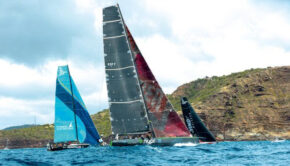
How to nurture a high performing team →

First to foil Giant multihull around world →
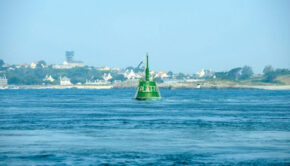
Using tides and tidal currents →
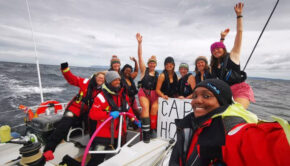
Being the only woman on board →
© 2024 Scuttlebutt Sailing News. Inbox Communications, Inc. All Rights Reserved. made by VSSL Agency .
- Privacy Statement
- Advertise With Us
Get Your Sailing News Fix!
Your download by email.
- Your Name...
- Your Email... *
- Name This field is for validation purposes and should be left unchanged.

TORNADO CATAMARAN Detailed Review

If you are a boat enthusiast looking to get more information on specs, built, make, etc. of different boats, then here is a complete review of TORNADO CATAMARAN. Built by Sailcraft Ltd. (UK) and designed by Rodney March, the boat was first built in 1967. It has a hull type of Catamaran Twin Cbrd. and LOA is 6.1. Its sail area/displacement ratio 83.99. Its auxiliary power tank, manufactured by undefined, runs on undefined.
TORNADO CATAMARAN has retained its value as a result of superior building, a solid reputation, and a devoted owner base. Read on to find out more about TORNADO CATAMARAN and decide if it is a fit for your boating needs.
Boat Information
Boat specifications, rig and sail specs, contributions, who designed the tornado catamaran.
TORNADO CATAMARAN was designed by Rodney March.
Who builds TORNADO CATAMARAN?
TORNADO CATAMARAN is built by Sailcraft Ltd. (UK).
When was TORNADO CATAMARAN first built?
TORNADO CATAMARAN was first built in 1967.
Member Boats at HarborMoor
- Tornado (sailboat)
The Tornado is a double handed multihull class recognised as an International Class by the International Sailing Federation. It was used for the Olympic Catamaran discipline for over 30 years.
- 1 Background
- 2.1 Olympics
- 2.2 World Championships
- 4 References
- 5 External links
The boat was designed in 1967 by Rodney March from the Isle of Sheppey , England. At the IYRU Olympic Catamaran Trials for international status, it easily defeated the other challengers.
To increase its performance even further, the Tornado was modified in 2000, with a new sail-plan which included a Spinnaker and Spinnaker boom, as well as an increased sail area of the existing sails. An additional trapeze was also added, and the jib was made self tacking.

The Tornado typically flies one of its two hulls; the crew balancing the boat with their own weight and by controlling the sails. With only one hull in the water, drag is significantly reduced. The Tornado also features an adjustable, rotating mast, which not only greatly improves the aerodynamics of the crucial leading edge of the sail, but also allows improved control over mast bend and thus mainsail flatness. For the high speeds and apparent wind directions seen by this high speed vessel, a flat sail profile is often required.
The Tornado is still among the fastest double handed catamarans, with an ISAF Small Catamaran Handicap Rating System rating of 0.934 and a D-PN of 59.0. [1] It is the fastest catamaran in the RYA Portsmouth Yardstick scheme, with a Portsmouth Number of 644. [2] Some have characterized the Tornado class as "the Formula One of sailing".
The Tornado was used as the as equipment for the multihull discipline in the Olympic Games from 1976 through 2008, when multihulls were deselected. Please see the individual years for results Olympic Sailing Regatta
World Championships
<templatestyles src="Module:Hatnote/styles.css"></templatestyles>
- List of multihulls
- ↑ Lua error in package.lua at line 80: module 'strict' not found.
External links
- The Tornado design official class rules
- International Tornado Association
- THE STORY OF THE TORNADO
- VIDEO OF THE TORNADO
- ISAF Tornado Microsite
- Commons category link is locally defined
- Classes of the International Sailing Federation
- Olympic sailboat classes
- Pages with script errors
Navigation menu
Personal tools.
- Request account
- View source
- View history
- Recent changes
- Random page
- Infogalactic News
- Buy an account
- What links here
- Related changes
- Special pages
- Printable version
- Permanent link
- Page information
- Cite this page
- This page was last modified on 31 October 2015, at 20:48.
- Content is available under Creative Commons Attribution-ShareAlike License unless otherwise noted.
- This article's content derived from Wikipedia, the Free Encyclopedia ( See original source ).
- Privacy policy
- About Infogalactic: the planetary knowledge core
- Disclaimers
- Mobile view
Great choice! Your favorites are temporarily saved for this session. Sign in to save them permanently, access them on any device, and receive relevant alerts.
- Sailboat Guide
1976 PantherCraft Tornado Sport Rig
- Description

Seller's Description
The Tornado Catamaran is one of the fastest production sailboats in the world. The Tornado was used as the equipment for the multihull discipline in the Olympic Games from 1976 through 2008. The rig was modified in 2001 to increase the Tornado’s performance even further with a new sail plan which included a spinnaker and spinnaker boom, as well as an increased sail area of the existing sails. An additional trapeze was also added, and the jib was made self tacking. Perfect if you are looking for a little more speed. This is a 70’s era Tornado built by PantherCraft in the UK. The boat has been upgraded to the Sport Rig with the square-top main, spinnaker, and self-tacking Jib as used in the Olympics. It would be a good choice for a sailor on a budget.Square-top Main and Self-tacking jib – Built by Elliot/Pattinson Sailmakers (High performance sailcloth, not class legal) Crispy Spinnaker – Built by Giorgio Zuccoli/Ullman Sails Italy Snuffer - Landenberger One Design - Dacron sleeve needs to be replaced Hulls – Painted, could be repainted Rudders and centerboards - fiberglass covered wood Rudder stocks – SailCraft of Canada Mast – Aluminum Standing Rigging - Excellent Trapeze wires – Vinyl covered stainless w/ Hi-Low Trapeze Adjustment Running rigging – Tapered mainsheet, tapered spinnaker sheets Trampoline – excellent, sewn with Teflon thread, no UV damage Boat covers – no special fitted covers, always used poly tarps. Trailer – 2006 Galvanized tilt trailer, new torsion bar suspension axle 2021 Boat and trailer are both registered with titles
Rig and Sails
Auxilary power, accomodations, calculations.
The theoretical maximum speed that a displacement hull can move efficiently through the water is determined by it's waterline length and displacement. It may be unable to reach this speed if the boat is underpowered or heavily loaded, though it may exceed this speed given enough power. Read more.
Classic hull speed formula:
Hull Speed = 1.34 x √LWL
Max Speed/Length ratio = 8.26 ÷ Displacement/Length ratio .311 Hull Speed = Max Speed/Length ratio x √LWL
Sail Area / Displacement Ratio
A measure of the power of the sails relative to the weight of the boat. The higher the number, the higher the performance, but the harder the boat will be to handle. This ratio is a "non-dimensional" value that facilitates comparisons between boats of different types and sizes. Read more.
SA/D = SA ÷ (D ÷ 64) 2/3
- SA : Sail area in square feet, derived by adding the mainsail area to 100% of the foretriangle area (the lateral area above the deck between the mast and the forestay).
- D : Displacement in pounds.
Ballast / Displacement Ratio
A measure of the stability of a boat's hull that suggests how well a monohull will stand up to its sails. The ballast displacement ratio indicates how much of the weight of a boat is placed for maximum stability against capsizing and is an indicator of stiffness and resistance to capsize.
Ballast / Displacement * 100
Displacement / Length Ratio
A measure of the weight of the boat relative to it's length at the waterline. The higher a boat’s D/L ratio, the more easily it will carry a load and the more comfortable its motion will be. The lower a boat's ratio is, the less power it takes to drive the boat to its nominal hull speed or beyond. Read more.
D/L = (D ÷ 2240) ÷ (0.01 x LWL)³
- D: Displacement of the boat in pounds.
- LWL: Waterline length in feet
Comfort Ratio
This ratio assess how quickly and abruptly a boat’s hull reacts to waves in a significant seaway, these being the elements of a boat’s motion most likely to cause seasickness. Read more.
Comfort ratio = D ÷ (.65 x (.7 LWL + .3 LOA) x Beam 1.33 )
- D: Displacement of the boat in pounds
- LOA: Length overall in feet
- Beam: Width of boat at the widest point in feet
Capsize Screening Formula
This formula attempts to indicate whether a given boat might be too wide and light to readily right itself after being overturned in extreme conditions. Read more.
CSV = Beam ÷ ³√(D / 64)
This listing is presented by TheBeachCats.com . Visit their website for more information or to contact the seller.
View on TheBeachCats.com
Embed this page on your own website by copying and pasting this code.
- About Sailboat Guide
©2024 Sea Time Tech, LLC
This site is protected by reCAPTCHA and the Google Privacy Policy and Terms of Service apply.

- CLASSIFIEDS
- NEWSLETTERS
- SUBMIT NEWS

The oldest video footage of Tornado catamarans racing
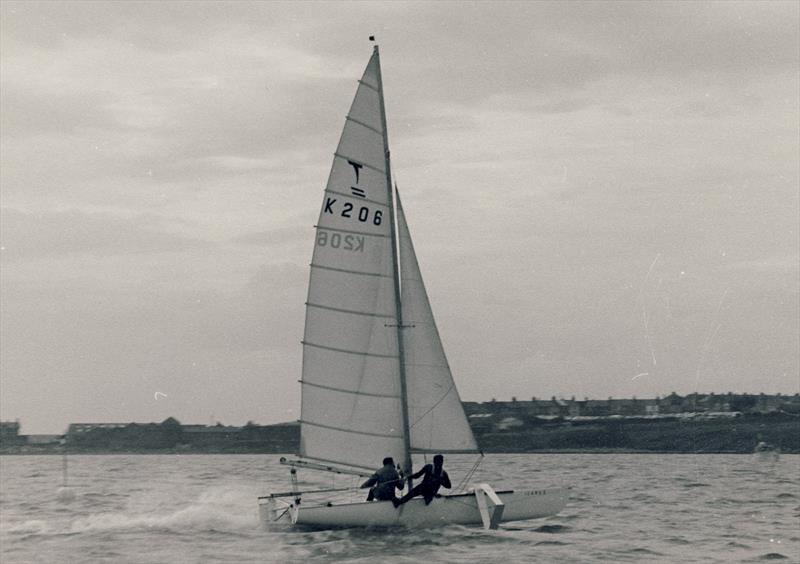
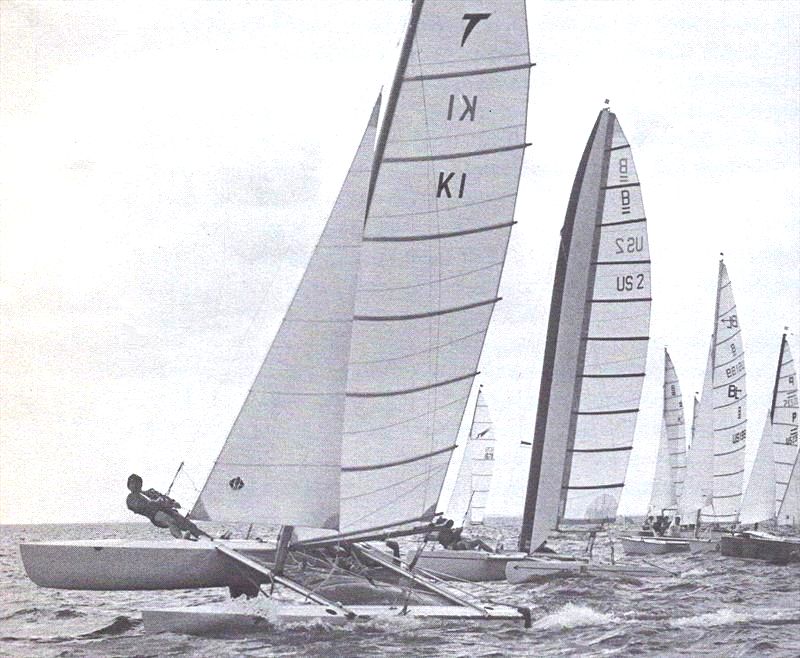
Related Articles
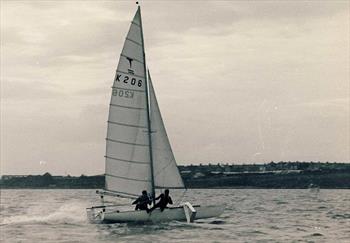
Upcoming Events

Catamaran Hull Speed Calculator For Beginners (Table and Free Spreadsheet)

As an Amazon Associate, we earn from qualifying purchases. We may also earn commissions if you purchase products from other retailers after clicking on a link from our site.
Speed is important, it can get you out of harm’s way, and it makes sailing much more fun, but figuring out how fast a catamaran will be able to sail can be tricky. One important aspect is to understand maximum hull speed.
In this article, I have calculated different hull speeds for different lengths of boats; this includes both monohulls and catamarans but focuses on the latter. Here is the catamaran maximum hull speed table:
Table of Contents
Catamaran Max Hull Speed Calculator Table
Table explanation.
- Length on the waterline (L.W.L.): Length of the boat when measured on the waterline, not to be confused with length overall (L.O.A.), which is the boat’s total length (above the waterline) including bowsprit, etc.
- Displacement max hull speed: The max speed of a boat whose L.W.L doesn’t change when underway and where the vessel’s bow wave is the limiting speed factor.
- Semi/Light Displacement or Semi planing hulls speed: A boat where the bow waves speed limiting factors can be partially overcome and therefore exceed the displacement hull speed. These hulls usually overcome hull speed by 10-30% .
How to use the Catamaran Hulls Speed Table
- Choose your length on waterline in the left-most column, either in feet or meter.
- Continue reading to your right and stop either at “Displacement hulls speed” or continue to “10,20, or 30%”, depending on your estimated hull efficiency. This will be your calculated maximum hull speed for a semi-displacement catamaran.
The Formula
First of all, we need to know the maximum hull speed for a displacement hull, and from that number, we will be able to calculate how much faster the semi-planing (or semi-displacement) hull will be. This is the formula for Maximum Hull Speed on a displacement boat:
Now we need to add the increased efficiency (loss of drag) of a semi-displacement hull, usually, this is somewhere between a 10-30% increase.
Note: “1.3” is the increase in efficiency, if you believe you are on the lower end of the scale this would be 1.2 or 1.1.
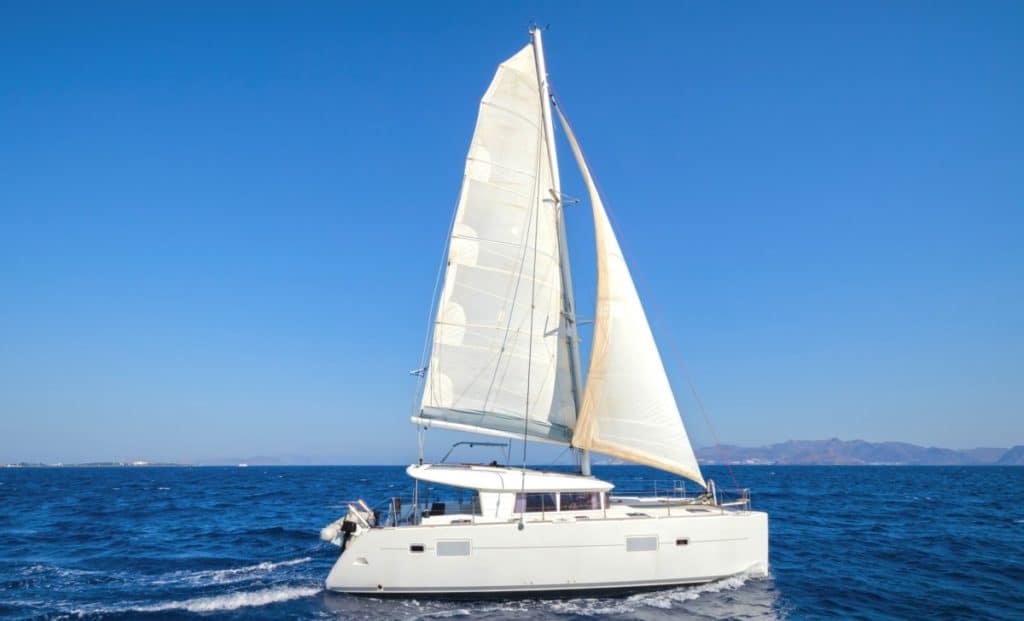
How to Exceed Hull Speed
This calculator offers a theoretical perspective, but many other factors such as sail plan, weight, and sailor skill, of course, have a profound impact on speed. As we have seen, a semi-displacement hull can exceed maximum hull speed, but we can also see that it isn’t by much. The next step is to reduce drag even further by utilizing a planning hull.
Catamaran Hull Speed Spreadsheet
If you want more info, calculate other lengths, or see the speeds in Km/h or Mph then I suggest you check out this free spreadsheet.
Catamaran Freedom Hull Speed Calculator
Note: If you want your own copy just click, File->make a copy.
Common Questions About Catamaran Hull Design
Below I will answer some of the questions I receive concerning catamaran hull design. The list will be updated as relevant questions come in.
Is a Catamaran a Planing hull?
As we have discussed above, a catamaran can definitely have a semi-planing hull, but can it be designed in a fully planing configuration as well?
Catamarans can be configured as planing hulls, although most sailing catamarans are set up as either semi-planing or hydrofoil. Due to the high speeds needed to get a boat to planing speed, this is only possible on racing sailboats or motor-powered catamarans such as high-speed ferries.
Owner of CatamaranFreedom.com. A minimalist that has lived in a caravan in Sweden, 35ft Monohull in the Bahamas, and right now in his self-built Van. He just started the next adventure, to circumnavigate the world on a Catamaran!
Leave a Reply Cancel reply
Your email address will not be published. Required fields are marked *
Save my name and email in this browser for the next time I comment.
Recent Posts
Must-Have Boat Gear for Catamaran Sailors!
Sailing is probably the most gear-intensive activity I've ever done; there are so many decisions to be made about what gear to buy now, for tomorrow, and what to definitely never buy. The gear on...
6 Best Trailerable Trimarans For Bluewater and Coastal Sailing
Having a boat costs a lot of money, even when you are not using it, marina fees, etc. And once it is in the water most sailors never go very far from their "home marina" and sailing will be somewhat...


Tuning Guide
Darren bundocks secret settings revealed, would you like to be member of the tornado class, meet the tornado.

Phone number
Email address
Your message
We'd like to occasionally send you communications via email to keep you up to date with the latest company information. Please confirm if you would like us to contact you by checking yes or no below. You can unsubscribe at any time. By submitting this form I confirm that all information provided is true, complete and accurate. For more information, please visit our privacy policy.
Yes, you can contact me No, please do not contact me
Home » Vessels » Tornado
An aluminium catamaran designed to remain at sea for extended periods

In 2015, CWind added two 23m LoA and two 26m LoA aluminium catamarans from Aluminium Marine Consultants (AMC), a shipbuilding and consulting company based on the Isle of Wight to the fleet. The new, larger vessels have boosted our fleet’s capability and enhanced our ability to serve client requirements.
CWind vessels can be chartered on their own or in combination with a range of our other service solutions.
The 23m Tornado incorporates 20-ton cargo capacity, large 14,000 litre fuel oil tanks and the ability to carry 2 x 10’ containers. Combined with above-deck accommodation for 3 crew and 12 passengers, the vessels are able to remain out at sea for extended periods of time.
Key Capabilities
Performance data, tank capacities, internal equipment, navigation/communication equipment, deck equipment, firefighting/life-saving equipment.

Our use of cookies
Privacy overview.
From dust devil to gustnado: Terrifying (and fascinating) tornado terms you should know

Tornadoes are among the planet's most fearsome phenomena, with terrifying and capricious wind speeds measured as high as 300 mph. And the U.S. sees more than any other country.
Some are small and nearly harmless; others huge and devastating. Their vortexes can appear and disappear quickly. Their paths can be erratic, unpredictable and difficult to trace. And their dynamic, fearsome nature is hard to explain.
So it's little surprise that there's a whole special vocabulary dedicated to describing tornadoes, their risks and related weather phenomena. Here's a list of tornado-related words, for everyone who has ever wondered what a gustnado or dust devil is.
Derecho : Not a tornado but a type of severe weather, a derecho is a widespread, long-lived wind storm associated with a band of rapidly moving showers or thunderstorms, according to the Storm Prediction Center . A derecho must include wind gusts of at least 58 mph and its wind damage swath must extend more than 240 miles. The term "straight-line wind damage" sometimes is used to describe derecho damage.
Dust devil : Usually smaller and less intense than a tornado, a dust devil is a swirling wind made visible thanks to the dust and debris it picks up. Dust devils often form on hot, clear days. (As if the name dust devil wasn't odd enough, this phenomenon is known as a "willy willy" in Australia .)
Enhanced Fujita (EF) scale: Tornadoes are classified on the Enhanced Fujita scale, which ranges from EF0 to EF5. Originally created by famed tornado researcher Ted Fujita, the scale takes into account estimated wind speeds, observed damage and damage verified in weather service surveys after tornadoes. Unlike hurricanes, which are based on the wind speed of a storm as it progresses, tornadoes are only rated after they've roared through a region.
Firenado : A firenado is a spinning vortex column of ascending hot air and gases that rises from a fire and carries smoke, debris and flame aloft, according to the Bureau of Land Management's Glossary of Wildland Fire Terminology.Also known as a fire tornado or a fire whirl .
Gorilla hail: A colloquial term to describe large hail, which sometimes accompanies tornadoes. So-called "Gorilla-size" hail is considered 2 inches in diameter or greater.
Gustnado : A whirlwind that forms on the edge of a thunderstorm. Despite what the name suggests, gustnadoes are not tornadoes.
Mammatus clouds : Blob-like clouds that form in cool, sinking air. They're usually associated with thunderstorms, but aren't necessarily a sign of severe weather, according to Forbes . The name comes straight from their appearance, as the clouds look just like mammaries.
Tornado emergency: A tornado emergency is reserved for what the weather service considers "exceedingly rare" situations when a severe threat to human life and catastrophic damage from a tornado are imminent or ongoing.
Tornado warning: A tornado warning means there is confirmation that a tornado has been spotted in your area or detected by weather radar and there is "imminent danger to life and property." When a tornado warning is issued, the weather service recommends finding your designated "safe place," preferably a small interior area with no windows.
Tornado watch: A tornado watch means tornadoes are possible because of specific weather conditions. People in the area of a tornado watch should be prepared to find a safe shelter if a warning is issued.
Waterspout: A waterspout is a whirling column of air and water mist, according to the National Ocean Service . They fall into two categories: Fair weather waterspouts, which usually form along the dark flat base of a line of developing cumulus clouds, or tornadic waterspouts, which are tornadoes that form over water, or move from land to water.

COMMENTS
The Tornado is a double handed multihull class recognised as an International Class by the International Sailing Federation. It was used for the Catamaran discipline at the Olympic Games from 1976 to 2008. Design One hull flying. The boat was designed in 1967 by Rodney March from the Isle of Sheppey, England.
The TORNADO first appeared as winner of the 1967 international "B" class catamaran trials. It was an Olympic class from 1976-2008. The class rules were changed to allow twin trapezes, 'flat head' mainsail, and asym. spinnaker.(2004?)
Tornado catamaran stats rating: Top speed: 20 knots LOA: 20ft/6.1m Launched: 1967 Berths: 0 Price: £23,000 Adrenalin factor: 70%. Carolijn Brouwer. A three-time Whitbread/Volvo Ocean Race crew ...
The Story of the Tornado, the Olympic Catamaran ... With its ability to reach speeds of 15-18 knots upwind and downwind, and 33+ knots reaching, the Tornado is truly the purists' speed machine. Over 4,800 Tornados have been built, with 1,200 class association members worldwide. In 2004, on the Saronikos Gulf in Greece, the Tornado will be ...
Tornado Catamaran is a 20′ 0″ / 6.1 m catamaran sailboat designed by Reg White and Rodney March and built by Sailcraft Ltd., Marstrom Composite AB, and Windrush Yachts starting in 1966. ... Hull Speed. The theoretical maximum speed that a displacement hull can move efficiently through the water is determined by it's waterline length and ...
☞ SUPPORT JOYRIDER TV⛵️Channel Membership https://www.youtube.com/channel/UC1lH...⛵️Patreon https://www.patreon.com/joseph_bennett ⛵️Getting a T-shirt ...
Tornado. Sporty small catamarans, such as the Hobie Cat and the Dart, hit the regatta scene in the 1960's. The IYRU announced B-cat trials in 1967, and the clear winner was the Tornado, designed by Englishman Rodney March. The class caught on well, and five years later got the nod as the Olympic catamaran, debuting in Kingston in 1976.
2000 Olympic Silver Medalists: Darren Bundock and John Forbes (AUS)The Tornado has since remained unchallenged as the ultimate one-design catamaran. With its modern, stylish rigging and sleek lines the Tornado is quick to catch the eye of any water-drawn on-looker as it speeds across harbors, lakes, and oceans in over 30 countries around the world.
The Tornado catamaran was for many years the fastest Olympic sailing class and was the first catamaran to be introduced to the Olympic Games. It was first sailed in the 1976 Olympic Games and saw ...
TORNADO 23m Catamaran KEY CAPABILITIES Year built 2015 Class MCA Cat 2 ... PERFORMANCE DATA Max speed 27kts Max deck cargo 15t Service speed 22kts Deck strength 1.5t/m ... The 23m Tornado incorporates 20-ton cargo capacity, large 14,000 litre fuel oil tanks and the ability to carry 2 x
Built by Sailcraft Ltd. (UK) and designed by Rodney March, the boat was first built in 1967. It has a hull type of Catamaran Twin Cbrd. and LOA is 6.1. Its sail area/displacement ratio 83.99. Its auxiliary power tank, manufactured by undefined, runs on undefined. TORNADO CATAMARAN has retained its value as a result of superior building, a solid ...
The Tornado was designed in 1967 by Rodney March from the Isle of Sheppey, England, specifically to be the Olympic Class catamaran. It easily defeated the other challengers in a selection event in England in the same year, and sailed its first Olympics in 1976.
For the high speeds and apparent wind directions seen by this high speed vessel, a flat sail profile is often required. The Tornado is still among the fastest double handed catamarans, with an ISAF Small Catamaran Handicap Rating System rating of 0.934 and a D-PN of 59.0.
The Tornado Catamaran is one of the fastest production sailboats in the world. The Tornado was used as the equipment for the multihull discipline in the Olympic Games from 1976 through 2008. ... Perfect if you are looking for a little more speed. This is a 70's era Tornado built by PantherCraft in the UK. The boat has been upgraded to the ...
It is updated weekly with the latest videos of sailing, but here we delve into the past, and round-up everything that shows early racing in the Tornado class. It could be said that the birthplace of the Tornado was during the IYRU A & B Catamaran Trials 1967 which we featured in an article a few weeks ago: Oldest videos of racing catamarans.
entertaining and it's another new innovation of the International Tornado Association (ITA) for 2010. The aim of this fresh approach to sailing is to breathe new life into the sport and bring the skills and thrills of Tornado catamaran racing to a wider audience and a new generation of spectators and sailors.
The Tornado class catamaran is a high performance yacht sailed by a crew of two people. Designed in 1966 by Rodney March, the Tornado almost instantly became an international class. The Tornado ...
This is the formula for Maximum Hull Speed on a displacement boat: Max hull speed= √((Length on Water Line x g) /(2 x pi)) x 3600/1852. Now we need to add the increased efficiency (loss of drag) of a semi-displacement hull, usually, this is somewhere between a 10-30% increase. Semi Displacement hull speed = Maximum hull speed * 1.3.
5cm down the stern. Swinging trapeze from top of bridle tang to stern of boat. 2. Rig Tension. 36 on Silver Loose Gauge, 27 on Black Loose Gauge. 3. Rotation. Pointing to back of centreboard case for single trapezing and above. To side stay for light winds.
The 23m Tornado incorporates 20-ton cargo capacity, large 14,000 litre fuel oil tanks and the ability to carry 2 x 10' containers. Combined with above-deck accommodation for 3 crew and 12 passengers, the vessels are able to remain out at sea for extended periods of time. View Vessel Data Sheet.
The two-handed Tornado catamaran was selected for the multihull discipline in the Olympic Games from 1976 through 2008. It was redesigned in 2000. ... (12 m) to achieve the same capacity. In addition to greater speed, catamarans draw less water than do monohulls— as little as 3 feet (0.91 m) —and are easier to beach. Catamarans are harder ...
☞ SUPPORT JOYRIDER TV⛵️Channel Membership https://www.youtube.com/channel/UC1lH...⛵️Patreon https://www.patreon.com/joseph_bennett ⛵️Getting a T-shirt ...
Tornadoes are among the planet's most fearsome phenomena, with terrifying and capricious wind speeds measured as high as 300 mph. And the U.S. sees more than any other country.
☞ SUPPORT JOYRIDER TV⛵️Channel Membership https://www.youtube.com/channel/UC1lH...⛵️Patreon https://www.patreon.com/joseph_bennett ⛵️Getting a T-shirt ...